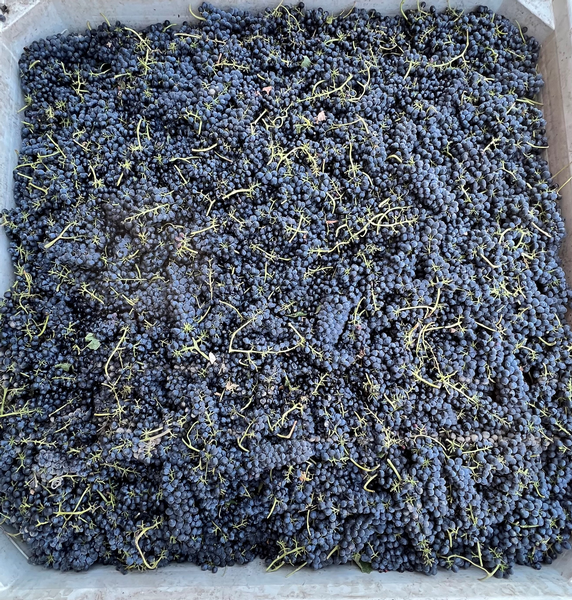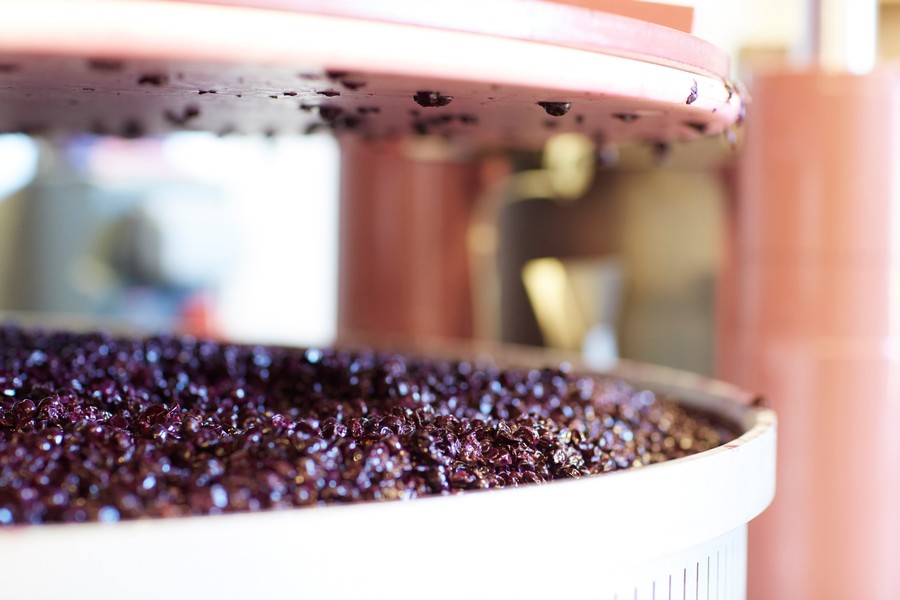Varietal Dive: Pinot Noir During Harvest
Working with Pinot Noir from the historic HMR vineyard is an honor, and we wanted to share how we care for this varietal during the most intense and vital harvest months.
On July 24th, we took photos of Pinot Noir clusters to document the beginning of veraison, the process of grapes turning from green to purple. For the next few months, slowly but surely, every berry in our 34 acres of Pinot Noir will go through veraison. On August 28th, the vineyard crew brought 13 buckets of Pinot Noir clusters to the winery from each of our 13 blocks to process and analyze. The blocks were sampled and analyzed weekly until harvest. After reviewing the analysis over two weeks and walking through each block tasting the fruit, our winemaker, Jeremy Weintraub, decided to pick 3.5 tons of Pinot Noir from Block 1H on Tuesday, September 12th. We will follow this block through the entire procedure of processing and fermentation.
When the harvest crew arrived at 6:30 a.m., 14 quarter-ton bins full of Pinot Noir were waiting on the crush pad. All of Adelaida’s picks are at night and early morning to ensure that the fruit is coming in at a cool temperature.

Freshly picked Pinot Noir, ready to be foot treaded either de-stemmed or with stems intact.
First, our cellar master weighed to determine how much fruit we were working with. Immediately after, the fruit went into the de-stemmer. This process separates the berries from the stems. The team decided that three bins would be left out of the de-stemmer to put into the tank to ferment as whole clusters. Adding whole clusters of fruit creates additional complexities in the wine by weaving in herbal and spice aromas while adding tannin structure and smoothing out high acidity.
The Pinot Noir from Block 1H was then loaded into one of our smaller concrete tanks from the top, starting with our three whole cluster bins, followed by the de-stemmed fruit. Later in the harvest, when we have less available tank space, determining which fermentation vessel to use is much more challenging). The fruit is then allowed to sit overnight in this tank that we have set to 50 degrees. We do not perform cold soaks at Adelaida; we set tanks at cooler temperatures to help protect the fruit until our natural fermentation begins, since this is one of the first ferments of the year, it may take a bit longer as yeast populations have not reached a level of abundance.
During fermentation, heat, alcohol, and CO2 are produced. This combination moves skins, seeds, and stems to the top of the fermenting juice, creating a cap. Cap management is an essential process of winemaking. Every morning and afternoon, measurements of sugar and temperature are taken to ensure the health of the fermentation. This aids in deciding what sort of cap management the ferment needs. Juice is passed through the cap by either pump over, punch down, or large bursts of air at the bottom of the tank. This disruption allows us to create more color, tannin, and mouthfeel for this wine. Once fermentation is completed and is dry, meaning all the sugar has converted to alcohol, the wine-making team tastes the contents of this tank for the next couple of days to decide when to drain the wine, separating the skins from the juice and pressing the remainder.
On the 11th day of being on skins, we drained the tank by gravity overnight into a stainless-steel holding vessel, otherwise known as free run. The following day, the tank of Pinot Noir was emptied by raking and shoveling out all the skins, seeds, and stems into our basket press. We pressed out all the remaining wine into two neutral barrels. The juice was then distributed between new French oak and neutral barrels. The pressed and free-run juice was kept separate from each other and moved to our barrel warehouse, where it will go through malolactic fermentation.

Grapes set to be pressed in one of our basket presses. This press gently squeezes skins, seeds, and pulp to extract the remaining juice not captured by the free-run process.
Throughout the next month, we will analyze samples from these barrels to monitor the malolactic fermentation, and by the end of November, these barrels will be ready to be put to bed and age for 15 months or so.
